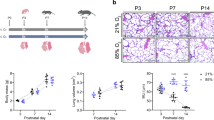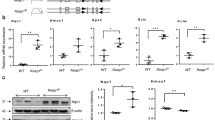Abstract
Background:
Caffeine is a nonspecific adenosine receptor antagonist used in premature neonates to treat apnea of prematurity. While its use may reduce the incidence of bronchopulmonary dysplasia (BPD), the precise mechanisms remain unknown. Evidence of increased adenosine levels are noted in chronic lung diseases including tracheal aspirates of infants with BPD. Utilizing a well-characterized newborn mouse model of alveolar hypoplasia, we hypothesized that hyperoxia-induced alveolar inflammation and hypoplasia is associated with alterations in the adenosine signaling pathway.
Methods:
Newborn murine pups were exposed to a 14-d period of hyperoxia and daily caffeine administration followed by a 14-d recovery period in room air. Lungs were collected at both time points for bronchoalveolar lavage (BAL) analysis as well as histopathology and mRNA and protein expression.
Results:
Caffeine treatment increased inflammation and worsened alveolar hypoplasia in hyperoxia-exposed newborn mice. These changes were associated with decreased alveolar type II (ATII) cell numbers, increased cell apoptosis, and decreased expression of A2A receptors. Following discontinuation of caffeine and hyperoxia, lung histology returned to baseline levels comparable to hyperoxia exposure alone.
Conclusion:
Results of this study suggest a potentially adverse role of caffeine on alveolar development in a murine model of hyperoxia-induced alveolar hypoplasia.
Similar content being viewed by others
Log in or create a free account to read this content
Gain free access to this article, as well as selected content from this journal and more on nature.com
or
References
Schmidt B, Roberts RS, Davis P, et al.; Caffeine for Apnea of Prematurity Trial Group. Caffeine therapy for apnea of prematurity. N Engl J Med 2006;354:2112–21.
Jobe AH, Bancalari E . Bronchopulmonary dysplasia. Am J Respir Crit Care Med 2001;163:1723–9.
Millar D, Schmidt B . Controversies surrounding xanthine therapy. Semin Neonatol 2004;9:239–44.
Schmidt B, Roberts RS, Davis P, et al.; Caffeine for Apnea of Prematurity Trial Group. Long-term effects of caffeine therapy for apnea of prematurity. N Engl J Med 2007;357:1893–902.
Zhou Y, Schneider DJ, Blackburn MR . Adenosine signaling and the regulation of chronic lung disease. Pharmacol Ther 2009;123:105–16.
Spicuzza L, Di Maria G, Polosa R . Adenosine in the airways: implications and applications. Eur J Pharmacol 2006;533:77–88.
Valls MD, Cronstein BN, Montesinos MC . Adenosine receptor agonists for promotion of dermal wound healing. Biochem Pharmacol 2009;77:1117–24.
Zhong H, Belardinelli L, Maa T, Zeng D . Synergy between A2B adenosine receptors and hypoxia in activating human lung fibroblasts. Am J Respir Cell Mol Biol 2005;32:2–8.
Kallapur SG, Jobe AH . Contribution of inflammation to lung injury and development. Arch Dis Child Fetal Neonatal Ed 2006;91:F132–5.
Huszár E, Vass G, Vizi E, et al. Adenosine in exhaled breath condensate in healthy volunteers and in patients with asthma. Eur Respir J 2002;20:1393–8.
Driver AG, Kukoly CA, Ali S, Mustafa SJ . Adenosine in bronchoalveolar lavage fluid in asthma. Am Rev Respir Dis 1993;148:91–7.
Blackburn MR, Volmer JB, Thrasher JL, et al. Metabolic consequences of adenosine deaminase deficiency in mice are associated with defects in alveogenesis, pulmonary inflammation, and airway obstruction. J Exp Med 2000;192:159–70.
Blackburn MR . Too much of a good thing: adenosine overload in adenosine-deaminase-deficient mice. Trends Pharmacol Sci 2003;24:66–70.
Chunn JL, Mohsenin A, Young HW, et al. Partially adenosine deaminase-deficient mice develop pulmonary fibrosis in association with adenosine elevations. Am J Physiol Lung Cell Mol Physiol 2006;290:L579–87.
Canpolat FE, Yurdakök M, Korkmaz A, Yigit S, Tekinalp G . Adenosine deaminase levels in premature infants with respiratory distress syndrome and bronchopulmonary dysplasia. J Matern Fetal Neonatal Med 2011;24:703–7.
Haskó G, Cronstein BN . Adenosine: an endogenous regulator of innate immunity. Trends Immunol 2004;25:33–9.
Rivkees SA, Zhao Z, Porter G, Turner C . Influences of adenosine on the fetus and newborn. Mol Genet Metab 2001;74:160–71.
Fredholm BB . Adenosine, an endogenous distress signal, modulates tissue damage and repair. Cell Death Differ 2007;14:1315–23.
Haskó G, Pacher P . A2A receptors in inflammation and injury: lessons learned from transgenic animals. J Leukoc Biol 2008;83:447–55.
Zhang N, Yang D, Dong H, et al. Adenosine A2a receptors induce heterologous desensitization of chemokine receptors. Blood 2006;108:38–44.
Cronstein BN, Levin RI, Philips M, Hirschhorn R, Abramson SB, Weissmann G . Neutrophil adherence to endothelium is enhanced via adenosine A1 receptors and inhibited via adenosine A2 receptors. J Immunol 1992;148:2201–6.
Zhou Y, Mohsenin A, Morschl E, et al. Enhanced airway inflammation and remodeling in adenosine deaminase-deficient mice lacking the A2B adenosine receptor. J Immunol 2009;182:8037–46.
Murphree LJ, Sullivan GW, Marshall MA, Linden J . Lipopolysaccharide rapidly modifies adenosine receptor transcripts in murine and human macrophages: role of NF-kappaB in A(2A) adenosine receptor induction. Biochem J 2005;391(Pt 3):575–80.
Thiel M, Chouker A, Ohta A, et al. Oxygenation inhibits the physiological tissue-protecting mechanism and thereby exacerbates acute inflammatory lung injury. PLoS Biol 2005;3:e174.
Ohta A, Sitkovsky M . Role of G-protein-coupled adenosine receptors in downregulation of inflammation and protection from tissue damage. Nature 2001;414:916–20.
Londhe VA, Sundar IK, Lopez B, et al. Hyperoxia impairs alveolar formation and induces senescence through decreased histone deacetylase activity and up-regulation of p21 in neonatal mouse lung. Pediatr Res 2011;69(5 Pt 1):371–7.
Cardoso W . Lung morphogenesis: role of growth factors and transcription factors. In: Harding R, Pinkerton K, Plopper C, eds. The Lung: Development, Aging, and the Environment. London, UK: Elsevier Academic Press, 2004: 3–11.
Rivkees SA, Wendler CC . Adverse and protective influences of adenosine on the newborn and embryo: implications for preterm white matter injury and embryo protection. Pediatr Res 2011;69:271–8.
Wendler CC, Busovsky-McNeal M, Ghatpande S, Kalinowski A, Russell KS, Rivkees SA . Embryonic caffeine exposure induces adverse effects in adulthood. FASEB J 2009;23:1272–8.
Mohsenin A, Mi T, Xia Y, Kellems RE, Chen JF, Blackburn MR . Genetic removal of the A2A adenosine receptor enhances pulmonary inflammation, mucin production, and angiogenesis in adenosine deaminase-deficient mice. Am J Physiol Lung Cell Mol Physiol 2007;293:L753–61.
Saiki S, Sasazawa Y, Imamichi Y, et al. Caffeine induces apoptosis by enhancement of autophagy via PI3K/Akt/mTOR/p70S6K inhibition. Autophagy 2011;7:176–87.
He Z, Ma WY, Hashimoto T, Bode AM, Yang CS, Dong Z . Induction of apoptosis by caffeine is mediated by the p53, Bax, and caspase 3 pathways. Cancer Res 2003;63:4396–401.
McColl SR, St-Onge M, Dussault AA, et al. Immunomodulatory impact of the A2A adenosine receptor on the profile of chemokines produced by neutrophils. FASEB J 2006;20:187–9.
ter Horst SA, Wagenaar GT, de Boer E, et al. Pentoxifylline reduces fibrin deposition and prolongs survival in neonatal hyperoxic lung injury. J Appl Physiol 2004;97:2014–9.
Weichelt U, Cay R, Schmitz T, et al. Prevention of hyperoxia-mediated pulmonary inflammation in neonatal rats by caffeine. Eur Respir J 2013;41:966–73.
Ohta A, Lukashev D, Jackson EK, Fredholm BB, Sitkovsky M . 1,3,7-trimethylxanthine (caffeine) may exacerbate acute inflammatory liver injury by weakening the physiological immunosuppressive mechanism. J Immunol 2007;179:7431–8.
Chavez Valdez R, Ahlawat R, Wills-Karp M, Nathan A, Ezell T, Gauda EB . Correlation between serum caffeine levels and changes in cytokine profile in a cohort of preterm infants. J Pediatr 2011;158:57–64, 64.e1.
EMERY JL, MITHAL A . The number of alveoli in the terminal respiratory unit of man during late intrauterine life and childhood. Arch Dis Child 1960;35:544–7.
Londhe VA, Maisonet TM, Lopez B, Jeng JM, Li C, Minoo P . A subset of epithelial cells with CCSP promoter activity participates in alveolar development. Am J Respir Cell Mol Biol 2011;44:804–12.
Londhe VA, Maisonet TM, Lopez B, et al. Conditional deletion of epithelial IKKß impairs alveolar formation through apoptosis and decreased VEGF expression during early mouse lung morphogenesis. Respir Res 2011;12:134.
Acknowledgements
We thank Bo-Chul Shin and the Devaskar lab, Neonatal Research Center, University of California, Los Angeles, for use and assistance with the immunofluorescence microscope. We also thank John Belperio in the Division of Pulmonary and Critical Care at University of California, Los Angeles for providing the hyperoxia apparatus.
Author information
Authors and Affiliations
Corresponding author
Rights and permissions
About this article
Cite this article
Dayanim, S., Lopez, B., Maisonet, T. et al. Caffeine induces alveolar apoptosis in the hyperoxia-exposed developing mouse lung. Pediatr Res 75, 395–402 (2014). https://doi.org/10.1038/pr.2013.233
Received:
Accepted:
Published:
Issue date:
DOI: https://doi.org/10.1038/pr.2013.233
This article is cited by
-
Caffeine is associated with improved alveolarization and angiogenesis in male mice following hyperoxia induced lung injury
BMC Pulmonary Medicine (2019)
-
Caffeine administration modulates TGF-β signaling but does not attenuate blunted alveolarization in a hyperoxia-based mouse model of bronchopulmonary dysplasia
Pediatric Research (2017)
-
Caffeine ameliorates hyperoxia-induced lung injury by protecting GCH1 function in neonatal rat pups
Pediatric Research (2017)
-
Loss of CD73-mediated extracellular adenosine production exacerbates inflammation and abnormal alveolar development in newborn mice exposed to prolonged hyperoxia
Pediatric Research (2017)
-
Caffeine Protects Against Anticonvulsant-Induced Neurotoxicity in the Developing Rat Brain
Neurotoxicity Research (2017)



